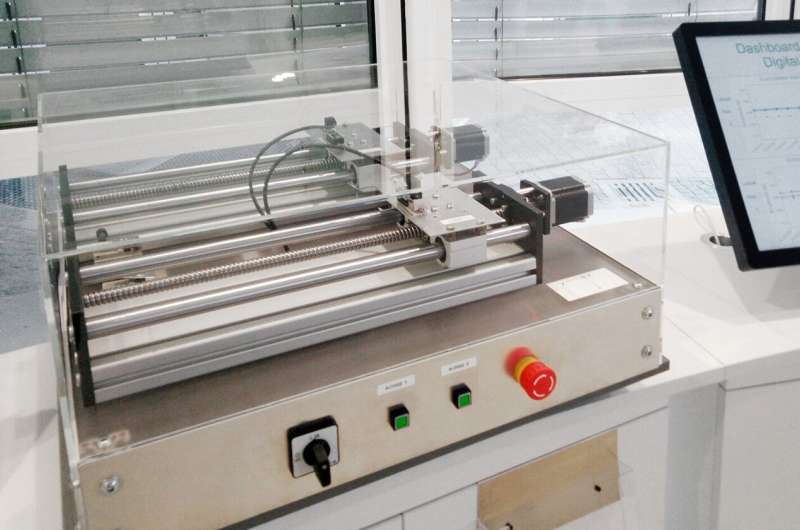Condition monitoring and data analysis in the cloud

In today's factories, to prevent damage to machines, sensors often trigger an alarm as soon as equipment begins to exhibit suspicious behavior—but rarely is this sensor data fully exploited. At the Hannover Messe Preview on February 12, 2020, researchers from the Fraunhofer Institute for Production Systems and Design Technology IPK will be showing just what is possible when sensor technology is connected to a cloud platform: perfectly coordinated workflow management and the optimization of entire fleets of machine tools.
Machine tools are precision apparatuses. They mill, turn and grind workpieces with micrometer accuracy. This precision can be achieved only when mechanical parts are working together perfectly and nothing vibrates. After all, vibrations can be transmitted to the tools and ultimately lead to errors and inaccuracies in the finished workpiece. When things go wrong, complaints follow and hit the manufacturer in the pocketbook. That's why it's important to recognize damage or wear to machines at an early stage. For this reason, many machines are monitored by sensors that can recognize—based on slight vibrations, for example—that a component is slowly becoming worn. The sensors can issue a warning signal that the part should be replaced before damage occurs. This is what is known as predictive maintenance, and there are now numerous predictive maintenance systems on the market.
Life cycle of machine tools saved in the cloud
Generally, however, predictive maintenance systems remain standalone solutions. Although they issue a warning so that a component can be replaced, this valuable information is rarely put to further use. Experts from Fraunhofer IPK in Berlin have now developed a system that does much more with predictive maintenance. They integrate the sensor technology into an internet platform that stores the full life cycle of one or more machine tools. This paves the way for comprehensive data analysis, which can be used to optimize machines or entire work processes. In an interesting demonstration, the team headed up by Claudio Geisert, deputy head of the Production Machines and System Management department at Fraunhofer IPK, will be showing how this works during the Hannover Messe Preview on February 12, 2020 in Hall 19 and during the trade show itself from April 20–24, 2020 at the joint Fraunhofer booth in Hall 6, Booth A26. For their demonstration, the researchers have chosen a key component of a machine tool: a ball screw drive, which moves a workpiece carrier in the machine extremely precisely back and forth on a spindle.
Such spindles can wear out over time, which leads to unwanted vibrations that can create faults in the workpiece—and which should be detected as early as possible. The smart maintenance system developed by Fraunhofer IPK does just that. At the heart of the system is a sensor circuit board that contains a commercially available sensor chip known as a micro-electro-mechanical system (MEMS). These MEMS are small silicon components that accommodate various interconnected technological modules on their surface. In this way they can, for instance, measure environmental stimuli, such as vibrations, and analyze them with a connected processor. The MEMS and processor together form a sensor node. "Millions of MEMS like these are fitted in cars and smartphones today. They are cost effective and yet sufficiently precise for our purposes," says Claudio Geisert. An important element is that the processing of the sensor signals takes place directly on the sensor node. Consequently, the processor recognizes a fault by itself and can pass this information on.
Digital twin of machine tool integrated into IoT platform
The information is transmitted to an Internet of Things (IoT) platform, which sends an alarm to the service headquarters, which then decides what to do. For example, it might set a suitable date for replacing the spindle to avoid production downtimes due to machine stoppages. In addition, this IoT platform contains a so-called digital twin of the machine tool—a digital copy that contains the history of the machine and all conditions and operating parameters.
Call up and analyze fleet history
If, in the end, the defective spindle is replaced, the digital twin also receives the information that it now includes a new component. "Replicating the actual condition of machine tools facilitates comprehensive analysis," explains Claudio Geisert. The operators of the machines would be able to recognize, for example, whether certain processes on the machines significantly increase wear, enabling work processes to be adapted accordingly. And the manufacturers of the machine tools can gain valuable indications for further optimizing their systems. "Ultimately, this lets you call up and analyze the history of an entire fleet of machines to find possible weaknesses," says Geisert.
Monitoring the machine fleet across locations
But connecting the real machine with the IoT platform also has advantages for the on-site staff who service the machine. In the IPK solution, technicians first scan a QR code on the machine in order to verify that they are working on the right machine. This is particularly important in companies that have entire machine fleets. The component can also be scanned and compared against the data in the digital twin—to ensure that another component isn't replaced by accident. In addition, employees can use a tablet computer to call up instructions for fitting and removing a component. Once the repair is done, they can start a test run directly from the machine. If everything has gone well, they press an OK button to give the signal to update the component in the digital twin as well. "By connecting the machine and the sensors to the IoT platform, we now get, for the first time, a holistic picture of a machine or an entire fleet," says Claudio Geisert. "This will enable large companies to monitor their full fleet of machines across individual locations." The IPK solution, which is being presented at the Hannover Messe Preview, is already so far developed that it can be used in industrial applications. It offers the possibility to adapt these technologies to the specific needs of various customers.



















